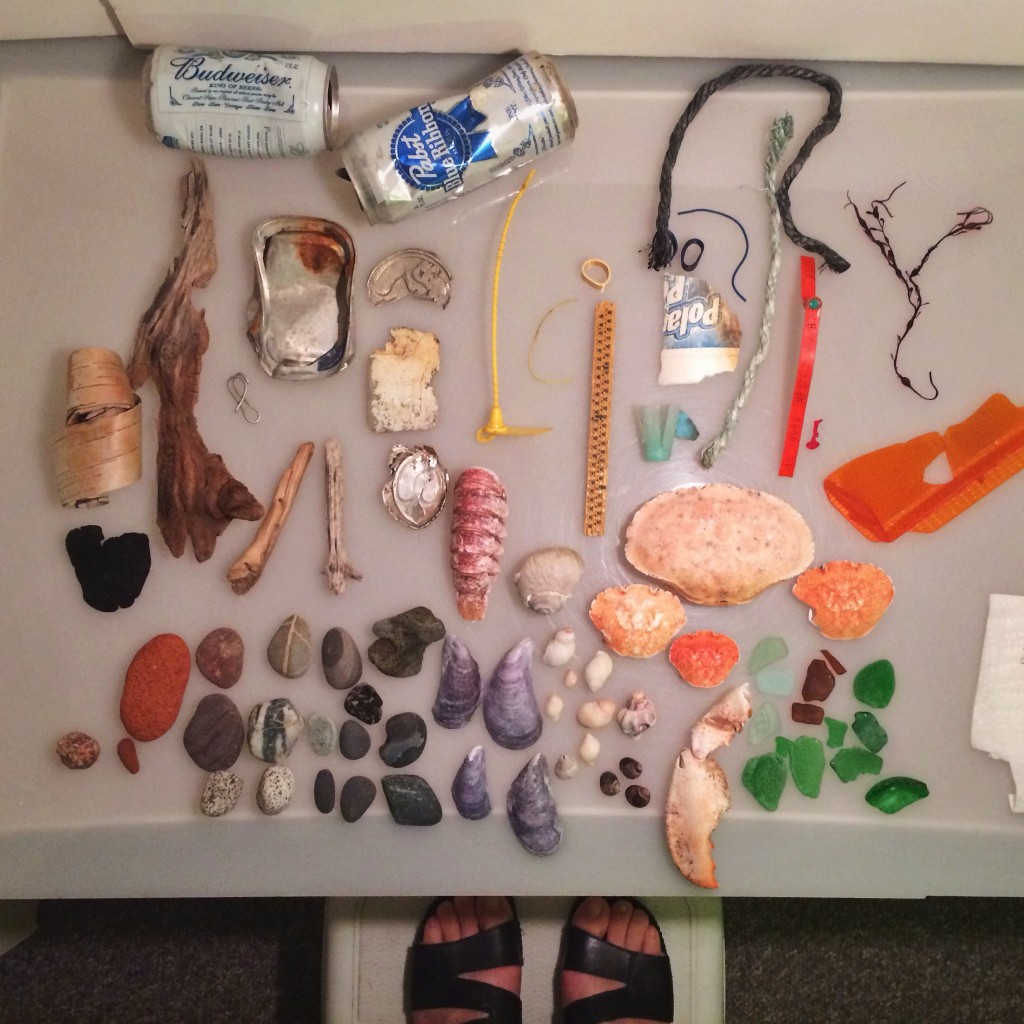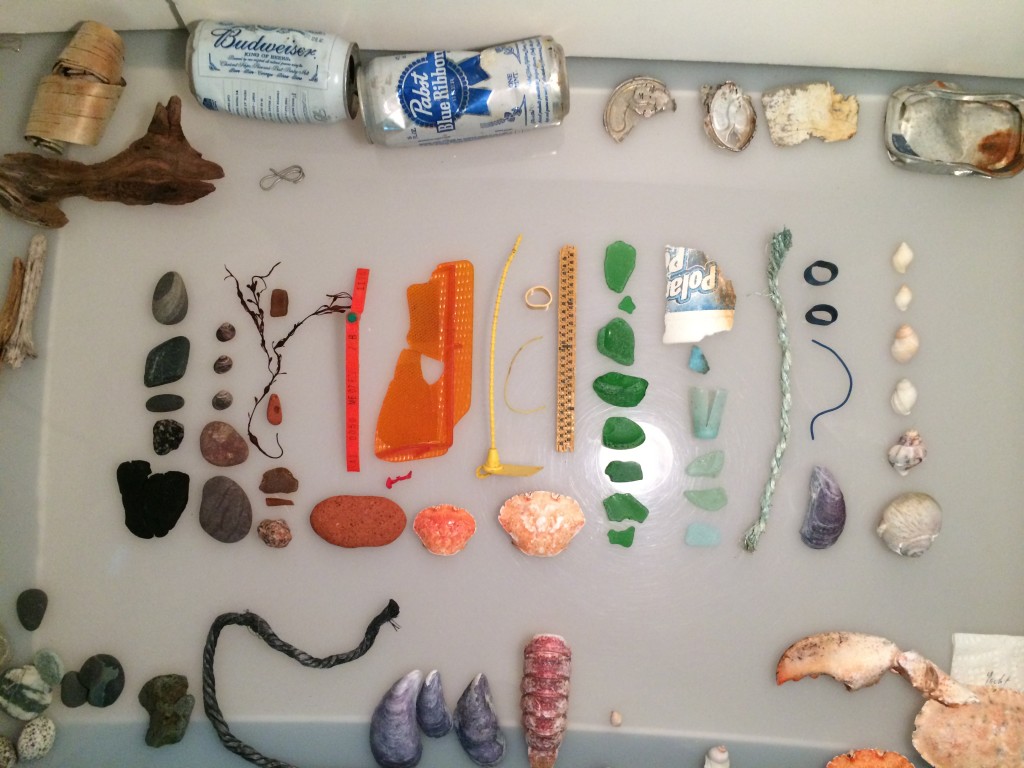Ever hear of a Blog Hop? It’s usually a chain of bloggers linking to one another with a common theme. I’ve been invited to join one that’s a little different – artists discussing their personal creative practice. Everyone who participates answers four questions:
What am I working on?
How does my work differ from others of its genre?
Why do I do what I do?
How does my process work?
I was invited by Jo Atherton, who weaves intricate and colorful tapestries out of rope and objects she gathers off the beaches of Cornwall. We’ve been chatting via email about the peculiarities and similarities of our beachcombing experiences. Jo’s post is here: http://flotsamweaving.com/blog/

What makes this particular blog hop so compelling is that these are really big questions. Since all the blogs link to the person who invited them, you can trace the questions back through dozens of artists, all of whom are making amazing work and each one has different answers to these questions. (Warning: it is possible to lose an hour very quickly following this thread – have fun!)
What am I working on?
My main focus right now is a series of still life photos that I’ve been working on for 5 years, called “The Beachcombing Series.” (You can see the whole thing in one place here.) Each photo in the series documents the things I found on a certain day: the title of each photo is the name of the beach and the date on which I found those objects. It’s a simple premise, but over the years it has developed into a very satisfying and complex practice: my walks on the beach have become a a kind of transect, partly scientific and partly poetic. The things I pick up are points of intersection between myself and the life of the shore. In the still lives, I plot those points of intersection and try to visualize the interconnected usages of the tidal zone. I write a blog post for each photo, noting the time of day, the kind of weather, and the things I noticed on the beach (like dead jellyfish and cool geology.) The blog posts help me sort through my impressions by recording all the data.
 On January 1, I’m starting an intense, two-year project (for which I’m still trying to find a name!) You can read my full description of the project here, but in summary I plan to walk all the way around Mount Desert Island’s shoreline. I’m inviting lots of people to join me to talk about their interest in the shoreline, whether it’s history, marine biology, tourism, fishing, geology, just about everything – and I’ll be posting those interviews on a dedicated blog. I’m partnering with local scientists to take advantage of the data I gather, and I’ll be producing a still life photo for each day of walking, which will also go up on the blog. I’m incredibly excited, can hardly wait to start, and a little overwhelmed at the logistics!
On January 1, I’m starting an intense, two-year project (for which I’m still trying to find a name!) You can read my full description of the project here, but in summary I plan to walk all the way around Mount Desert Island’s shoreline. I’m inviting lots of people to join me to talk about their interest in the shoreline, whether it’s history, marine biology, tourism, fishing, geology, just about everything – and I’ll be posting those interviews on a dedicated blog. I’m partnering with local scientists to take advantage of the data I gather, and I’ll be producing a still life photo for each day of walking, which will also go up on the blog. I’m incredibly excited, can hardly wait to start, and a little overwhelmed at the logistics!
How does my work differ from others of its genre?
There are a lot of people who make beautiful photographs of found objects or natural debris on a white background, that is certainly not unique to me. Mary Jo Hoffman’s gorgeous Still blog comes to mind immediately. I don’t know of anyone else using still life to explore complex chaotic systems, though. Frankly, I’m not even sure what my “genre” is – is it still life photography, is it SciArt, is it documentary? I find it very hard to respond when people ask what I do, because if I say “I’m a photographer,” they imagine weddings and portraits, so whenever possible I say, “I’m an artist,” pull out my iPhone, and just show them.
Why do I do what I do?
I can’t help myself, I’m fascinated with this whole process – I love going out on the shore and looking intently at it. I’ll squat over a tidepool and watch barnacles feeding, or go out when it’s 5º below zero so I can see the ice freezing in ripples as the tide ebbs. And then I bring all that back to the studio in my head and in the objects I’ve picked up, and try to make this visual expression of everything I observed. I have images in my head that have to come out, it’s that simple. I had to learn photography and lighting and Photoshop to get them out, though, which was not simple.
How does my process work?
I find having a clearly defined framework for a project is incredibly helpful. You can skip the floundering stage of ‘what should I make?’ and move straight into trying to express ideas through that framework. As I said above, mine is to make a photograph from things I pick up in one beachcombing session. So I go out, spend a couple of hours beachcombing and bring home a pile of flotsam and then spend anywhere from a day to a couple of weeks trying to find the right combination of objects and the right balance:
Eventually I find a composition that feels right, at which point I set up the lights and photograph it. It takes me a day or two of work in Lightroom and Photoshop to make sure every object is evenly lit and has equal visual weight. That’s tricky for me, since some objects are dark and velvety, like periwinkle shells or coal, and others are bright and reflective, like sea glass, so they all respond differently to light.




Jennifer, I think your new project sounds exciting (and ambitious)! I’m eager to see all your blog and Instagram posts on it and buy a copy of the finished book. Best of luck to you.
Great blogpost.Will you please add bloglovin button to that blog too so that I can follow you?AriadnefromGreece!